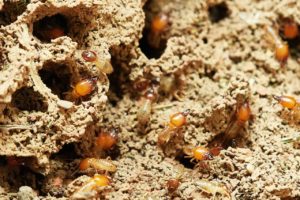Are Termite Inspections Required Before Buying a House in Maryland?

Lenders may require a “wood destroying insect inspection”, frequently referred to as a termite inspection, when buying a house in Maryland. This is because it is risky for lenders to approve loans on houses that have been damaged by termites and other wood-destroying insects. However, if damage is found during the inspections and subsequently treated and repaired, lenders will typically move forward with approving the loan.
What are Termites?

Termites are those creepy pests no one wants to see or think about. They are known as “silent destroyers” because they can chew through wood without being detected.
Although they may start out underground, a few strategically constructed and placed mud tubes may allow them entry into the home.
They can also gain access to the home through wood that is in contact with the soil. This includes porch steps and supports, doorframes, deck supports and more.
Evidence of an infestation doesn’t have to throw a real estate transaction into turmoil. The homeowners may have no clue they have a problem caused by wood-eating insects. Buyers don’t necessarily have to be scared. Any damage caused by wood-eating insects and frequently be repaired and treated.
What Parts of a House are Inspected During a Termite Inspection in Maryland?
According to the Maryland Real Estate Contract of Sale, the following areas are included in the inspection:
- The interior of the residence (including the basement)
- 3 feet surrounding the residence
- The garage or within 3 feet of the garage (this applies to both attached and detached garages)
- Any outbuildings located within 3 feet of the residence or garage
- A maximum of 10 linear feet of the nearest portion of a fence on the property that is within 3 feet of the residence or garage
What Does A Termite Inspector Look For in Maryland?

A termite inspection is a visual inspection. The inspector will look for signs of damage. The inspector will also typically use a screwdriver to probe certain areas os wood beams to determine if the wood is soft from termite unseen activity.
- The mud tubes mentioned earlier are one indication of an infestation. For several reasons (access to a food source is one), termites construct these tubes from the soil to wood. Sometimes the inspector has no trouble finding mud tubes. Sometimes, they are hidden inside walls, behind the homes baseboards, under the floors and behind walls.
Check out Orkin’s website to learn more about mud tubes and to see photos to help you identify them.
- The inspector will also look for termite wings. Like moths, termites may cluster around light sources, so one sign of an infestation are their wings littering windowsills or stuck in cobwebs.
- The inspector may check any wood structures on the property, such as fencing, wood mulch in the garden, firewood stacks and wooden structures.
- Termite damage is a sure-fire sign of an infestation, so the inspector looks for evidence of such on wood surfaces, such as floors.
The inspector will also look for evidence of a few other types of wood-destroying insects. These insects include: carpenter bees, carpenter ants and powder-post beetles.
What are Carpenter Bees?
Carpenter bees resemble bumble bees. Unlike termite, they do not eat wood. Instead, carpenter bees make tunnels in the wood to use as nests. They are typically found in the eaves of a house, decks, porches, fascia boards and siding. Occasionally they can also be found in attics. They use the nests during the winter, then emerge in the spring.
During the inspection, the inspector will look for: holes in the wood, sawdust on the ground under where the hole was drilled, pollen and feces near the hole entrance, and actual flying bees.
What are Carpenter Ants?
Like carpenter bees, carpenter ants damage wood by making nests. They appear as giant ants, and generally seek wood that has been previously damaged by decay, moisture, or other insects. They frequently enter a house through attic vents, cracks, and foundations. They will then build their nests in wood such as windows, doors, and walls.
During the inspection, the inspector will look for visible ants. Sometimes, piles of wood shavings will be visible under wood items.
What are PowderPost Beetles?
This type of wood-destroying insect lays their eggs in wood. After the eggs hatch, the young beetles eat the wood and create tunnels. As they become adults, they eat their way out of the wood and leave tiny exit holes. This entire process can take 2-5 years, which means the wood is being eaten for years.
During the inspection, the inspector will look for tiny holes and also evidence that these pesky beetles have emerged from those holes. A tell-tale sign is the residue left behind after they exit. The inspector will typically see a finely-ground mixture of excrement and wood shavings.
Who Pays For The Termite Inspection When Buying a House in Maryland?

The buyer pays for the wood destroying insect inspection in Maryland. The only exception to this is the buyer who is using a VA loan. In this instance, the buyer is not allowed to pay for the inspection, and the seller becomes obligated to pay. Fortunately, termite inspections are not expensive, and many inspection companies allow payment to be made at settlement.
What does a Termite Report Look Like When Buying a House in Maryland?
The wood-destroying insect report (Maryland termite report) will include several sections. The report will show which sections of a property were inspected. At times there are areas of a property that are not accessible. Those inaccessible areas will be noted. Likewise, the accessible areas will be noted.
The report will provide the details of a visual inspection. Did the inspector see signs of infestation? If the inspector saw dead wood-boring insects or evidence thereof, it will be noted.
Likewise, the inspector will include a map of the property, and point out which areas have damage caused by wood-destroying insects. Lastly, the inspector will include an estimate for the treatment to rid the property of wood-destroyimg insect damage. The homeowner is not obligated to use a specific pest company to repair and treat any damage. The homeowner is encouraged to obtain estimates and employ the treatment company he or or she feels is the best choice.
What Happens if Termites are Found During an Inspection? Does the Seller Pay for Treatment & Repairs?
The Maryland inspection report will indicate if there is any insect damage, either current or old. The report will also indicate whether the inspector found any signs of previous treatment. If there are any signs of current activity or damage, the Maryland Real Estate Contract of Sale states the seller will be obligated to have it treated and pay for the repairs after the inspection.
Specifically, the Maryland Contract of Sale states:
If there is evidence of present infestation, or if damage caused by present of prior infestation is discovered, Seller, at Seller’s expense, shall repair any damage caused by present or prior infestation and have the present infestation treated by a licensed pest control company.
Is There a Limit to How Much A Seller Must Pay to Have Termite Damage Treated?
According to the Maryland Contract of Sale, the seller is obligated to have termite damage treated at a cost of up to 2% of the purchase price of the house.
If the cost of treatment and repair exceeds 2% of the purchase price, the seller may cancel the Contract of Sale. However, if the buyer chooses to pay for the cost of treatment and repairs that exceeds the 2% of the purchase price, the contract will remain in effect and can not be cancelled by the seller.
In conclusion, a “wood-destroying insect inspection” is required when a home buyer is obtaining a loan to buy a house is Maryland. Many properties have no evidence of wood-destroying pests. From a lender standpoint, they want to be sure they are financing homes that aren’t at risk of deterioration from bugs. If there happens to be signs of pest activity and/or damage, it doesn’t have to be a deal-breaker. Termite and other pest damage can often be treated and repaired. It’s not an automatic deal-killer when a house is under contract. Inspection reports and negotiations will often remedy any issues that are found during a wood-destroying insect inspection in Maryland.
Recommended Termite Inspectors in MD
Questions? Get Answers From the Local Real Estate Pro!





